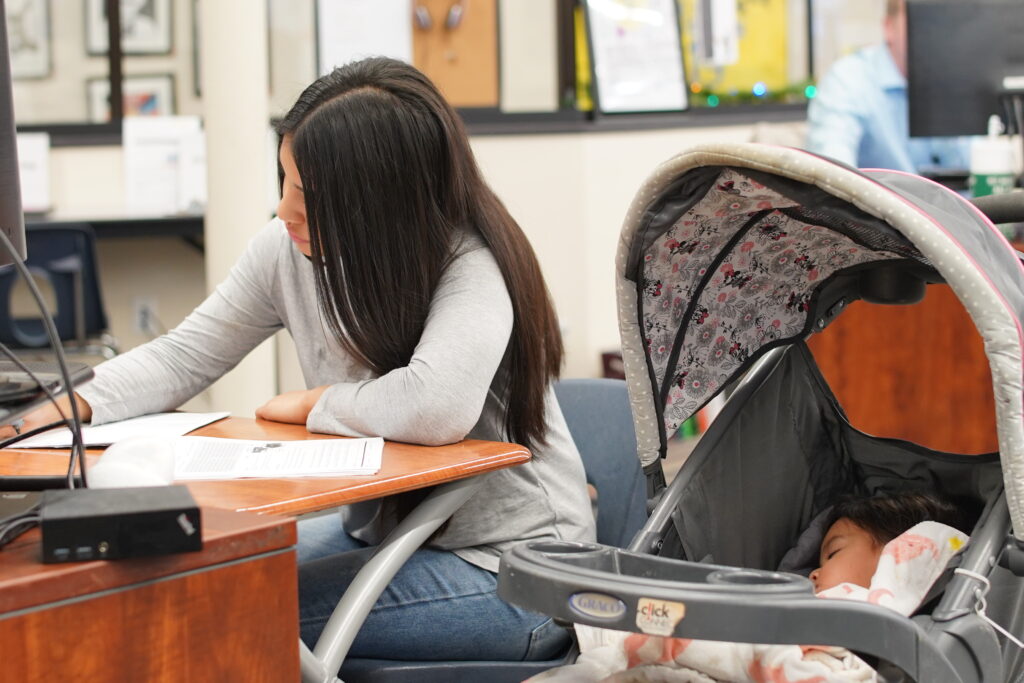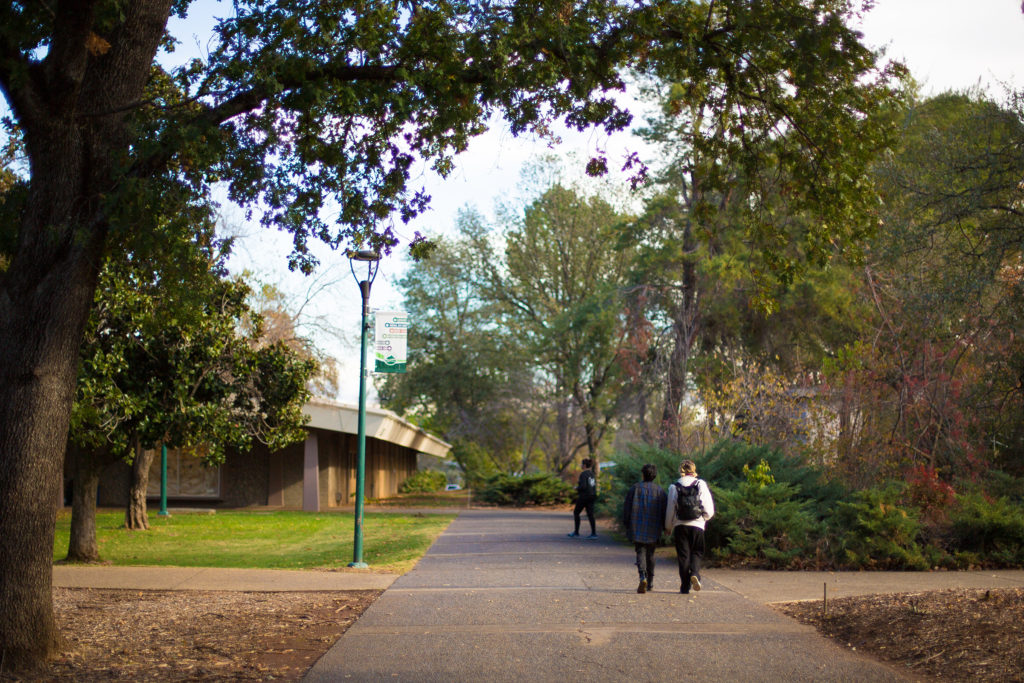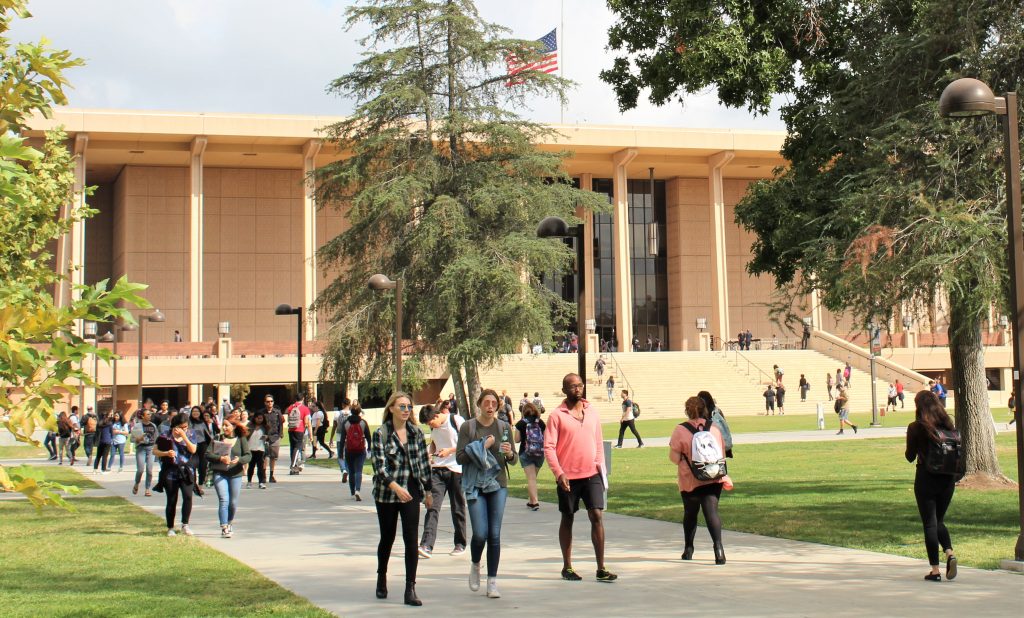
File photo of a student in the HOPE (Helping Our Parenting Students Excel) program. At varying levels, HOPE is a part of nearly 50 Learn4Life centers in California. Some schools only provide donations for baby supplies and access to support groups while larger schools have separate classrooms for its HOPE students, including the Hanford campus.
Photo courtesy of Learn4Life
Pregnant in high school, 14-year-old first-year high school student Giselle Meza said she feared she’d be judged by her peers. She was one of only two pregnant teens at her school and felt isolated. She missed a lot of classes, falling behind.
Statistically, Meza has about a 50% chance of dropping out of school altogether. She hasn’t; instead, she withdrew from Hanford High to participate in Helping Our Parenting Students Excel at Kings Valley Academy, a Learn4Life campus — a network of dozens of public charter high schools across the state and nation.
The HOPE program and Learn4Life structure empowered her to walk onto the campus without feeling alone. The program provided her with peer support from other pregnant and teen parents, a personalized learning plan, and the ability to bring her daughter to school.
In a designated HOPE room at Kings Valley Academy, shelves stocked with children’s books line the walls. Educational toys, playpens and swings cover the floor.
The room is a home away from home, where Meza could nurse, tend to or play with her daughter, Desirae, while continuing her high school education and gaining skills to better herself.
Teen parents have thrived in that environment, including Nevaeh D. who earned a full scholarship to UCLA after graduating from Learn4Life. “While I did my lessons, she was sleeping or playing alongside me,” Nevaeh said in an April media release announcing her graduation from Learn4Life. For student privacy, the school did not disclose Nevaeh’s last name.
“So many of them think they’re the only ones in this position,” HOPE founder Staci Roth said. HOPE, however, creates an environment where pregnant and parenting teens feel seen, safe and supported, Roth told EdSource.
After more than a year in the program, Meza, now 16, no longer feels isolated, and is comforted by “being surrounded by people going through the same thing.”
“We take away the shame and the stigma,” said Christianna Percell, assistant principal at Kings Valley Academy.
How HOPE started
Seven years ago in 2016, while working at Learn4Life Panorama City in Los Angeles, Roth noticed that pregnant and teen parents struggled to attend class. She started a group with teen moms to learn what obstacles were preventing them from coming to and staying in school.
Schools needed to do more to support them, she said. She designated one classroom for the group of teen parents and brought in swings and bouncers, diapers and wipes.
“Just made it their safe space,” she said.
By 2018, HOPE had grown from eight to 63 students in the Learn4Life schools, as word spread that parenting students could bring their kids to campus.
At varying levels, HOPE is now a part of 48 Learn4Life centers in California. Some schools only provide baby supplies and access to support groups, while larger schools have separate classrooms for its HOPE students, which, to Roth, has been the best way to achieve the organization’s goal of creating a safe space for parenting students to feel supported.
Learn4Life’s Hanford location adopted the program three years ago with about a dozen parenting teens. Today, the program serves almost 60 teen parents, said Lindsey Hoskins, the supervising teacher who oversees the HOPE program in Hanford.
“I was a teen parent,” Hoskins said. “There was no place I could take my baby.” She said she remembers having the choice of dropping off her child while she was at school or staying home to nurse the baby.
As a result of HOPE, Hoskins said student parents aren’t dropping out like they were before the program’s implementation.
Being supported
The HOPE program allows students with children to bring their kids to school, so they can work toward a high school diploma at their own pace while receiving mentorship, supplies and peer support. Students have access to essentials such as diapers, car seats, strollers, cribs, clothes and toys, so the teens don’t feel pressured to work as much or to spend their earnings on baby supplies.
Instead, the student parents can focus on their education and their children, Roth said.
The program provides resources by connecting the teens to community partners, providing transportation when needed or simply offering encouragement.
“We may be providing diapers and formula now while they’re at school,” Roth said, “but at the same time, connecting them to where they can get that in the future if they need it.”
The peer support ensures the parenting teens don’t feel alone and allows them to learn from each other, Roth said.
In the HOPE room, parenting teens often step in and help with a crying baby that has colic, Roth said. Or during a support group meeting, they’ll bounce ideas off of one another to treat a rash. “They’re their best teachers to each other.”

Students also learn life skills, such as financial planning, lessons about child development, health and nutrition, as well as job readiness and career skills.
Over time, HOPE programs have added elective classes to teach parenting skills; Roth said students can learn to be better parents while gaining needed credits to graduate.
Created based on student input, skills classes range from preparing for childbirth and breastfeeding to building healthy relationships and co-parenting. Hoskins said students can pick a topic that’s specific to their life or situation. Some of Hoskins’ students have completed classes for potty training and teething — which has allowed them to gain confidence and address the challenges they currently face as a parents.
“They feel so empowered to take care of their little ones,” Roth said.
According to a 2010 study of women in their early 20s, 53% of women who became moms as teenagers graduated with a high school diploma, in contrast to 90% of women who did not become teen parents.
Such statistics, Roth said, were the driving force behind HOPE’s goals: teaching teens how to parent and to support their family while encouraging and equipping them to go to college or find a career after high school.
Students supported by the HOPE program graduate at a 6% higher rate, according to Learn4Life and HOPE statistics.
Addressing the whole child
Several parenting students said they joined HOPE because they no longer felt comfortable at their traditional schools after becoming pregnant, the Learn4Life staff said.
“We’ve heard the stories from our students (about) how they felt at their school when they found out they were pregnant,” Roth said.
To break that cycle, HOPE staff builds supportive relationships, Roth said.
“We say we’re going to be here, and we are here,” she said. “We say we’re going to support them, and we do support them. It’s life-changing for them to have someone who asks about their day (and) to call your teacher in emergencies.”
HOPE students can be teen mothers or fathers as well as students who help care for their siblings. Kristen Cooper, 17, nearing the completion of her sophomore year, brings her one-year-old brother to the program while her parents work. She said she gained trusting relationships with adults because of the program.
The HOPE and the Learn4Life school model allows staff to build lasting, meaningful relationships with students by addressing all their needs.
The school’s model focuses on one-on-one instruction, flexible scheduling and personalized learning, said Ann Abajian, a spokesperson for Learn4Life. Students, including those in HOPE, have the option to work virtually or spend minimal hours at school.
A “team of teachers” manages students’ action plans and goals as they get “layers of support” through tutoring; one-on-one, small group and traditional class instruction; three school counselors and an onsite therapist; resiliency programs, such as yoga, meditation and classes that teach organizational skills and coping mechanisms; and an alumni support group.
That support helps students navigate their challenges, including not being able to attend a traditional school because they’re dealing with social-emotional trauma, working every day, helping care for a sibling or raising a child.
Staff members are trained to be trauma-resilient education professionals who provide tools to build the resilience to face their past, present and future, said Roth, who is also the school’s coordinator of trauma-resilient education.
Students who take part in the HOPE program, Roth said, come to the Hanford campus for one-on-one instruction with their teachers. The difference for HOPE students is the designated space to bring their children.
Meza, the student who joined HOPE to avoid judgment at her traditional school, spends a lot of time on campus because she feels more comfortable there than in her own home, she said. There’s more room for her one-year-old daughter to play, and she gets the help she needs from staff.
“I’ve been doing better than ever, honestly,” Meza said about now being nearly finished with her first year of high school.
HOPE is ‘different’ from other youth parenting programs
Schools in California have operated youth parenting programs for decades. Currently, programs are under the umbrella of Cal-Learn, a state program designed to encourage pregnant and parenting teens to graduate from high school or gain the equivalent, become independent and form healthy families.
Sixty percent of teenage parents who are currently receiving welfare will depend on government aid for 10 or more years, according to research noted in the legislation that established Cal-Learn to address the “unique educational, vocational, training, health, and other social service needs” of teen parents.
The Youth Parent Program in Clovis Unified, for example, serves parenting teens who are trying to graduate.
With a 91% graduation rate, the parenting program supports students on their journey to finishing high school and helps them gain basic parenting skills, district spokesperson Kelly Avants said.
The program is meant to “come alongside” students who are teen parents, ensuring they have access to transportation, nursing, counseling, academic support, encouragement to “stay in school, pass their classes and ultimately graduate,” and the skills to “parent well,” Avants said.
Through the program, teen parents can learn areas such as basic infant CPR, lessons on childhood development and ways to be engaged parents.
But HOPE is different, Hoskins said, because it’s on Learn4Life campuses, where educators can give students what they need with specific programming, such as personalized learning and the elective classes picked by students.
“We meet them where they are,” Hoskins said.
‘Impacting generations’
The percentage of teen parents who do not finish school contributes to high incidences of their own children not graduating.
The federal Centers for Disease Control and Prevention found that the children of teenage mothers are more likely to drop out of high school, give birth as a teenager and face unemployment as a young adult, among other findings.
Generational impact on kids
A child who comes to campus sees their parent studying — something HOPE staff believe will foster a child’s love for school and can break the cycle of dropping out.
Mayra Hernandez, 18, said her 2-year-old son Sebastian loves his preschool and isn’t shy like some of the other kids because he attended HOPE with his mom for the first two years of his life. She said Sebastian eagerly plays with and communicates with his peers.
Parenting teens, Hoskins said, are “bringing their child who is exposed to books (and) exposed to mom reading,” Hoskins said. “They’re exposed to literature, structure, education, other peers and social behavior and norms.”
“(Teen pregnancy) has such a generational impact,” Roth said. “This population has its own obstacles and trauma that go along with (being a teen parent).”
Acknowledging those “high statistics,” Roth and Hoskins said the aspects of the HOPE program — bringing kids to campus, graduating from high school, gaining life and parenting skills and learning about careers — are “impacting generations.”
“I would be struggling still,” 18-year-old Mayra Hernandez said in hindsight. Her mom, also a teenage mother, didn’t graduate from high school. Hernandez, considered an 11th grader, said she is better able to manage her time as a mother and student because of HOPE’s and Learn4Life’s model. She is dual enrolled in high school and the West Hills Community College District and works two jobs to pay her bills.
She considers herself on track to graduate and pursue a career. Hernandez gained nearly 60 credits in just a month at Learn4Life, has completed a semester of college through dual enrollment and plans to either become a traveling nurse, ultrasound technician or a medical professional in the Navy.
Hernandez said it will be “inspiring” for her son to see her graduate.
Meza said she once viewed the military as her only option after graduation, but now after high school, her goal is to become an ultrasound technician — all because HOPE expanded what she viewed as her choices.
“A lot of our students will tell you, ‘I would not graduate high school if it wasn’t for Learn4Life and the HOPE program,’” Hoskins said. “Things that are deemed not possible are happening.”




